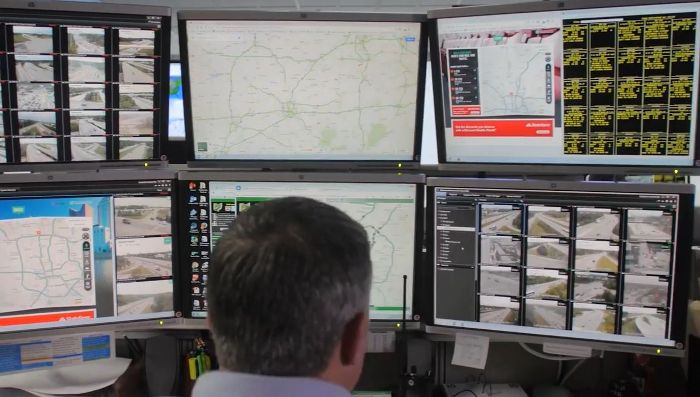As part of Ohio’s efforts to be a leader in using technology to improve traffic flow and road safety, construction has started on the state’s first SmartLane peak time congestion relief scheme on a 7 miles (11km) long stretch of Interstate 670 in the Columbus area.
To create the new SmartLane, the Ohio Department of Transportation (ODOT) will be converting the left-side hard shoulder into an additional travel lane on I-670 between the city’s downtown and the John Glenn International Airport during peak travel times. Similar to the UK’s widely-used Smart Motorway system, the lane capacity enhancement scheme is the first project of its kind in the state. State-of-the-art digital overhead signs will be installed every three-quarters of a mile to let motorists know if the lane is open to traffic or closed by displaying either a red ‘X’ or a green arrow. The SmartLane will generally be open Monday through Friday during the evening rush hour, about 3:30 p.m. to 6:30 p.m. The lane will only be opened during off-peak times if traffic conditions warrant a need for it. 
The state’s most recent biennial budget legislation also gave ODOT the authority to lower the speed limits on I-670 when the SmartLane is open. New high-definition cameras will be installed along the route that will allow ODOT’s statewide Traffic Management Center (TMC) to monitor the SmartLane 24/7 and ensure there are never vehicles or debris in the lane before it opens to traffic. In addition to the technology upgrades, the project also includes rebuilding the left shoulder on I-670 eastbound to better accommodate drivers in the SmartLane, resurfacing I-670 between I-71 and I-270, and reconfiguring the interchange at I-670, I-270 and US 62. The US$60m project is expected to be complete by the end of 2019.
 “This project is a smart investment for Ohio. By re-purposing the shoulder, which already exists, and investing in state-of-the-art technology, we are able to decrease congestion in this corridor without the high costs and long timelines associated with highway widening,” explained ODOT’s director, Jerry Wray. “It might sound counter-intuitive, but studies have shown travelling at slower speeds actually keeps traffic moving better because it avoids the ‘stop and go’ conditions which can cause more accidents. Ultimately, we believe the combination of the extra travel lane and the reduced speed limits will allow for a more reliable commute for travelers along that route.”
“This project is a smart investment for Ohio. By re-purposing the shoulder, which already exists, and investing in state-of-the-art technology, we are able to decrease congestion in this corridor without the high costs and long timelines associated with highway widening,” explained ODOT’s director, Jerry Wray. “It might sound counter-intuitive, but studies have shown travelling at slower speeds actually keeps traffic moving better because it avoids the ‘stop and go’ conditions which can cause more accidents. Ultimately, we believe the combination of the extra travel lane and the reduced speed limits will allow for a more reliable commute for travelers along that route.”
 ODOT is also testing new technology aimed at stopping wrong-way crashes, with new signs and detectors being installed along an 18 mile (30km) long stretch of I-71 in the Cincinnati area. The US$1.2m system includes 92 electronic signs and 82 detection devices at 23 locations, including the on- and off-ramps. When drivers attempt to drive in the wrong direction, LED lights around the edge of several ‘Wrong Way’ and ‘Do Not Enter’ signs begin blinking. If they proceed, the sensors will immediately alert law enforcement agencies and ODOT’s TMC in Columbus. The route’s selection was based on a survey of 911 calls, number of crashes, volume of traffic, and proximity to ‘alcohol establishments’. The system has also been used in more limited tests on I-670 in Columbus, and on SR-2 in Cleveland.
ODOT is also testing new technology aimed at stopping wrong-way crashes, with new signs and detectors being installed along an 18 mile (30km) long stretch of I-71 in the Cincinnati area. The US$1.2m system includes 92 electronic signs and 82 detection devices at 23 locations, including the on- and off-ramps. When drivers attempt to drive in the wrong direction, LED lights around the edge of several ‘Wrong Way’ and ‘Do Not Enter’ signs begin blinking. If they proceed, the sensors will immediately alert law enforcement agencies and ODOT’s TMC in Columbus. The route’s selection was based on a survey of 911 calls, number of crashes, volume of traffic, and proximity to ‘alcohol establishments’. The system has also been used in more limited tests on I-670 in Columbus, and on SR-2 in Cleveland.





